In the past few months, I have come to realize that some of the most common words are just downright confusing. Protein is one of them. I decided to write about it because the more involved in nutrition, metabolism, biochemistry and physiology I become, the more confusion I recognize among people in discussions about protein. I find most people are confused about the meaning of the words protein and carbohydrates. It is important to understand what protein is in order to be healthy—I will discuss carbohydrates in a future paper.
The Many Meanings of Protein
Depending on the branch of science, or even in everyday life, the word “protein” has acquired different meanings.
In Restaurants: meat or seafood
Metabolism and Nutrition: a macronutrient that is present in many foods
Chemistry: “any of a class of nitrogenous organic compounds that consist of large molecules composed of one or more long chains of amino acids and are an essential part of all living organisms, especially as structural components of body tissues such as muscle, hair, collagen, etc., and as enzymes and antibodies.” (see this google definition here)
Physiology: specially folded complex large molecular structures made up of amino acids, from which most everything is made in the human body (see here)
Biology: “Any of a group of complex organic macromolecules that contain carbon, hydrogen, oxygen, nitrogen, and usually sulfur and are composed of one or more chains of amino acids. Proteins are fundamental components of all living cells and include many substances, such as enzymes, hormones, and antibodies, that are necessary for the proper functioning of an organism. They are essential in the diet of animals for the growth and repair of tissue and can be obtained from foods such as meat, fish, eggs, milk, and legumes.” (see here)
Origin of the Word Protein
The word protein first appeared in the journal Natuur by G. J. Mulder in 1838, who chose the Greek prōteios as the base for the word (see here). While he didn’t quite discover the entire concept of what protein was, he most certainly captured its most commonly understood quality very well:
“…This is the foodstuff of the whole animal kingdom…” (here)
Indeed, it is foodstuff, however, it is also the biggest component of our body after water. Most of us are unaware that we have protein in our body and would be hard pressed to point to something in our body that is protein. We do know that we need to eat protein for health but what exactly is protein?
Protein
I nearly dropped out of my first biochemistry class because I was unable to relate to protein—the way it was explained was quite insufficient. In college, most everyone is presented with a picture similar to this:
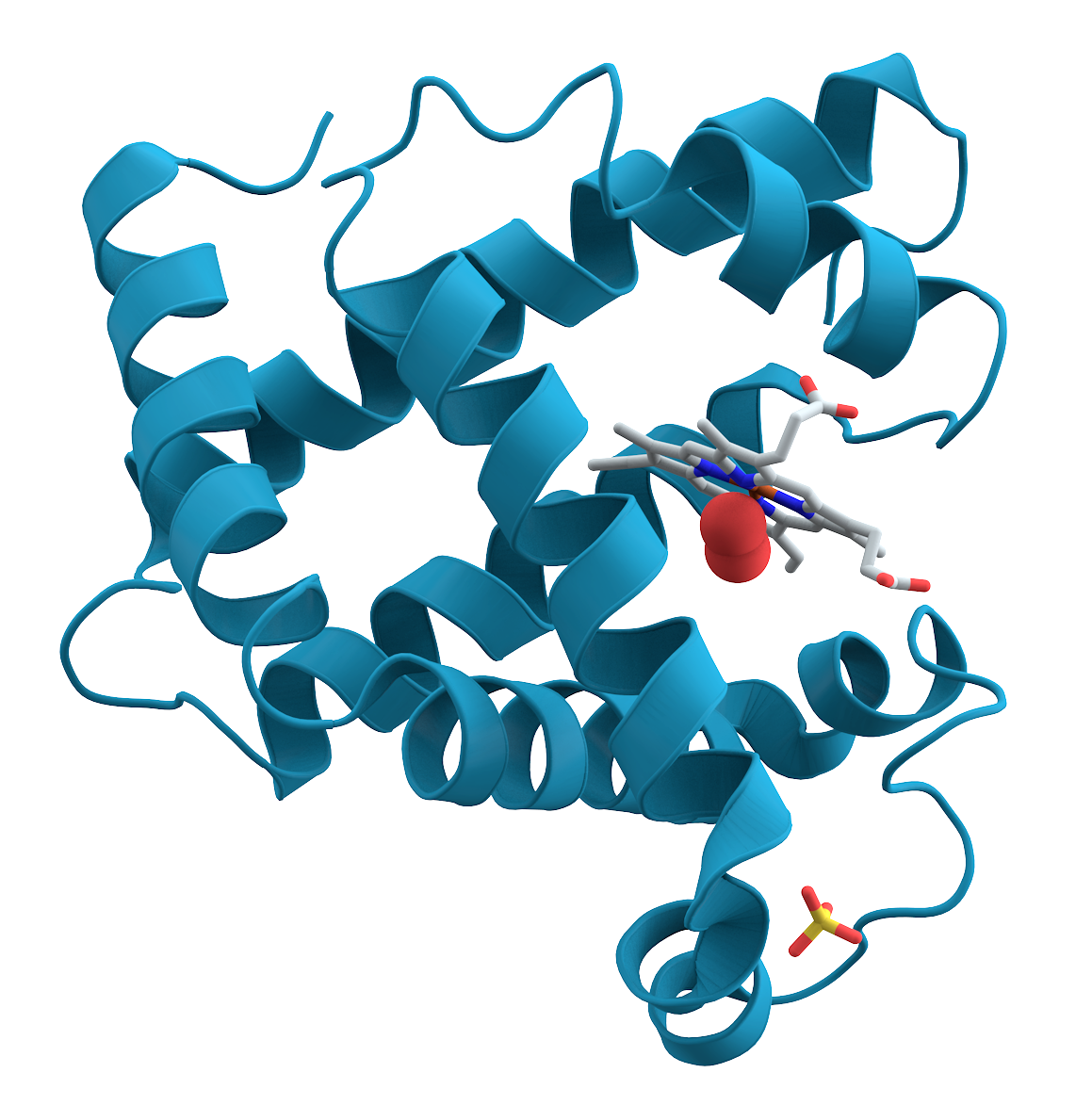
and we are told: this is what protein looks like. Other than looking like bad hair day due to inexpert use of a curling iron, not much else comes to mind. The curls are labeled as “protein folding” but few teachers do a good job explaining what that means, and why they look like that. And no one I know has ever explained to me how the shape of this protein relates to the protein in the food I eat. Let me approach the subject in the order of the many meanings I listed above, starting with the most common concepts and move to the more complicated ones.
Protein in Restaurants
How often have you heard a waiter/waitress ask: what would you like for your protein? This is an interesting question. We all seem to know that the question refers to meat or seafood. What if you order a salad or a pasta dish with no meat or seafood at all? Are you still ordering a protein?
Most every food type, including fruits, vegetables, grains, legumes, nuts, seeds, dairy, poultry, meat, and seafood contain protein, though none is completely protein. The only food element that does not contain protein is fat. There is no food that is 100% protein, even protein powders are not 100% protein, so you cannot order 100 % protein for your meal, no matter how hard you try.
The confusion gains more importance when someone is trying to find out how much protein should be consumed a day. The USDA recommends a minimum of 0.6 protein grams per 2 lbs of weight for women and 0.8 grams per 2 lbs of weight for men. (see here) On average this comes to about minimum 50 protein grams a day. So how to calculate how much protein one actually eats? For example, if you eat a serving of chicken breast, or drink a glass of milk, or eat a bowl of salad: how much protein are you consuming? While a milk carton lists the protein content (usually 8 protein grams per 8 oz glass of milk), a serving of chicken breast and a bowl of salad most certainly doesn’t list any information. The next best place to look up protein information per each food item is the USDA database.
The USDA offers a standardized approach of protein value per 100 gr (3.5 ounces) of food stuff. For example, the amount of protein in this cooked chicken breast per 100 gr is 27.3 gr (here). If you prefer salad, it depends on the kind of lettuce, of course. I picked Romaine lettuce for an example: 100 gr Romaine lettuce has 1.23 gr protein (here). Since most everything we eat has protein, the question of “what would you like for your protein?” could be answered by ordering any food. While I do not want you to torture the wait-staff with your newly found knowledge, just remember, in reality we don’t eat protein, we eat foods that have protein.
Protein in Metabolism and Nutrition
Protein is one of the four macronutrients that encompass all foods humans can eat and drink, except for water: Carbohydrates, Protein, Fats, and Alcohol—I will ignore alcohol in this article. When evaluating a particular nutritional paradigm, such as the Standard American Diet (SAD), Mediterranean, LCHF, Vegetarian, Ketogenic, Carnivore, DASH, Whole30, Paleo, South Beach, Vegan, etc., we choose based on its macronutrient composition. Looking at two extremes for macro composition: the vegan diet is approximately 70-80% carbohydrates (Ornish plan), less than 10% fat, and the rest is from protein. A straight opposite to vegan is the ketogenic diet, which is 70- 90% fat, 4-5% carbohydrates, and the rest protein (see an example here). As you see, understanding what protein means in your diet is absolutely necessary in order to pick a particular nutritional paradigm and follow it correctly. Understanding what protein actually is, is also very important, so that you don’t get confused about what you are eating and why.
Macronutrients
Carbohydrates
Carbohydrate is also a misunderstood word, which I will cover in an upcoming paper to greater detail. In our common use in discussions about nutrition it refers to foods that contain glucose, starch, sucrose, fructose, galactose, and/or fiber. A typical carbohydrate is Romaine lettuce. As I noted earlier, most carbohydrates contain protein and fat as well. There are carbohydrates that contain only sugars, such as table sugar, honey, and candy. Fiber is often referred to as a carbohydrate even though we cannot digest fiber. Our gut flora can digest fiber and provide nutrients to us in exchange. The nutrient we receive is butyrate. Butyrate is a short chain fatty acid (here) and a ketone precursor (see here)—it is a fat.
Protein
As mentioned above, proteins are referred to as meats, seafood, poultry, and eggs. However, I have shown that they are not protein, they merely contain protein. Some seafood and most organ meats also contain glucose—something I just defined as belonging under carbohydrates. There are no foods in which the amount of protein takes up most of the food. When we eat meat or seafood, we also eat large amounts of fat and water. I looked through the USDA database for common raw foods protein value and found that turkey breast has the highest protein amount at 23.66 gr per 100 gr, salmon came in second at 22.25 gr per 100 gr (salmon protein differs widely among fish type, farmed or wild, and the geographic location it comes from), and chicken breast came in third at 20.85 gr protein per 100 gr.
Fat
Fat is a simple macronutrient. When we eat most fat types, we only eat fat.
Macronutrient summary: The confusion about certain macronutrients is that it is unclear at what point a food becomes carbohydrate versus protein, since just about anything we choose to eat contains glucose, protein, and fat, with the notable exception of sweeteners. Therefore, of the three macronutrients, only fat stands alone as a “pure” macronutrient as it has neither carbs nor protein.
Essential macronutrients are those that we must consume in order to stay alive and be healthy. We only have two essential macronutrients in our food: protein and fat; carbohydrates are not essential macronutrients (see here).
Protein in Chemistry
Protein is “a class of nitrogenous organic compounds that consist of large molecules composed of one or more long chains of amino acids and are an essential part of all living organisms, especially as structural components of body tissues such as muscle, hair, collagen, etc., and as enzymes and antibodies” (see this google definition here). There are 20 amino acids, of which 9 are essential and 11 are not.
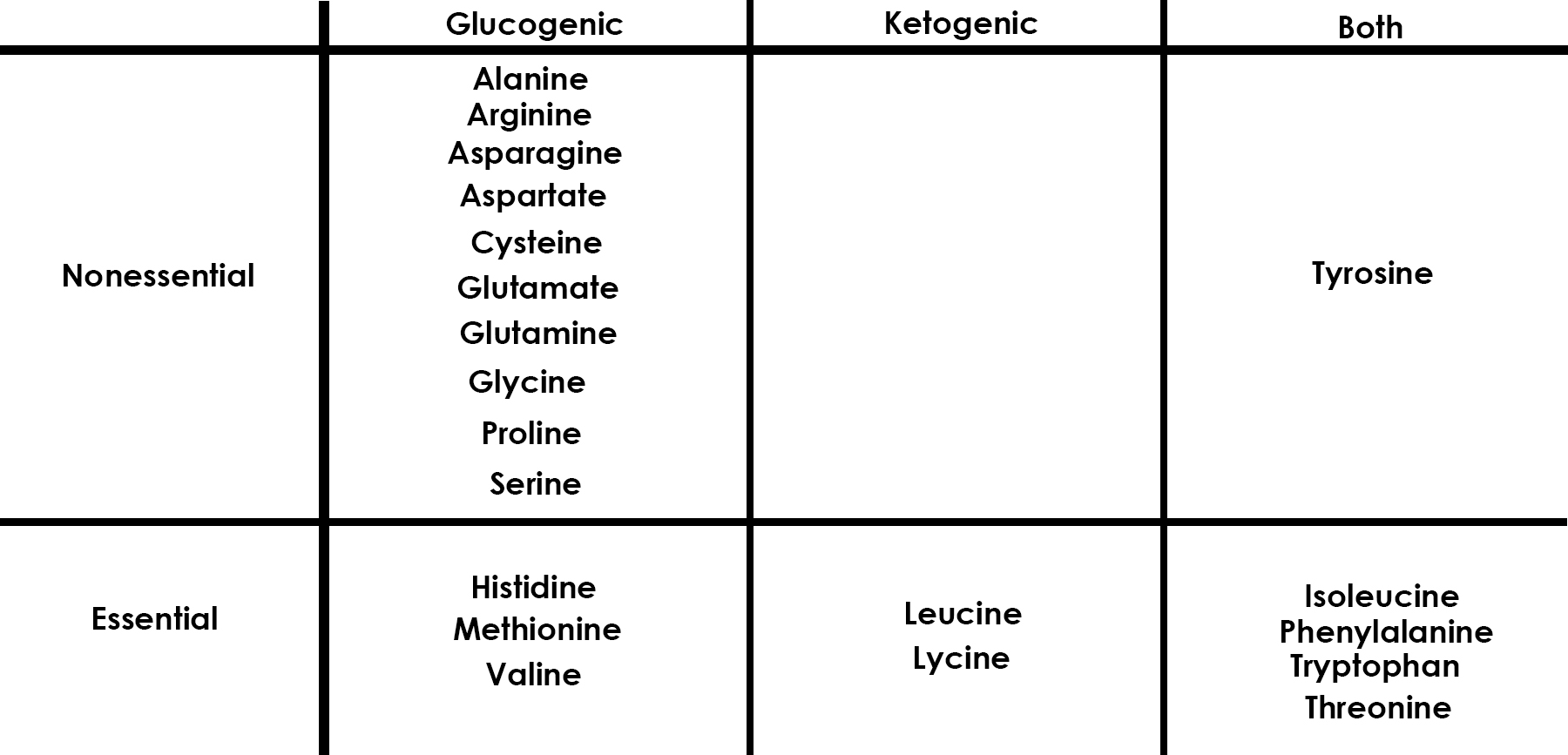
Table 1. Amino acid types
Some amino acids can only convert to glucose (glucogenic), some only to ketones, and some to either.
Each amino acid is a combination of carbon (C), nitrogen (N), hydrogen (H) and oxygen (O). The total number of proteins that can be created from these amino acids by organic metabolic processes is not yet known, but it is certainly an extremely large number. In humans, it is over twenty thousand (here). Even our genes are made from proteins.
Translating amino acids to our foods: glucogenic amino acids convert to glucose, thereby stimulating insulin. Ketogenic amino acids don’t stimulate insulin; they are more “metabolically stable”. Metabolically stable in this context refers to the fact that ketogenic compounds decrease oxidative stress and inflammation better (see here) than glucogenic ones do. Since most foods that contain protein contain most amino acids but in various different amounts, it is wise to select foods that are higher in essential amino acids that contain more of the ketogenic kinds. Looking at the amino acid composition of foods is not an easy challenge but can be done using the USDA database’s “full report (all nutrients)”, such as I selected here for flank steak. The more nutrient dense foods will have higher levels of the ketogenic amino acids.
I have collected several popular foods, looked up their individual amino acid compositions, and then grouped them and created three comparison ratios: essential versus non-essential, ketogenic versus glucogenic or (ketogenic + either) versus glucogenic. The goal is to show that different foods have different values for our body in terms of their protein content. The table below is a summary of the following foods picked by popular eating trends: chicken breast, black beans, soy beans, brown rice, romaine lettuce, eggs, whole milk, Atlantic salmon, porterhouse steak, pork loin, ground beef, ground turkey, ground lamb, and tomato*.
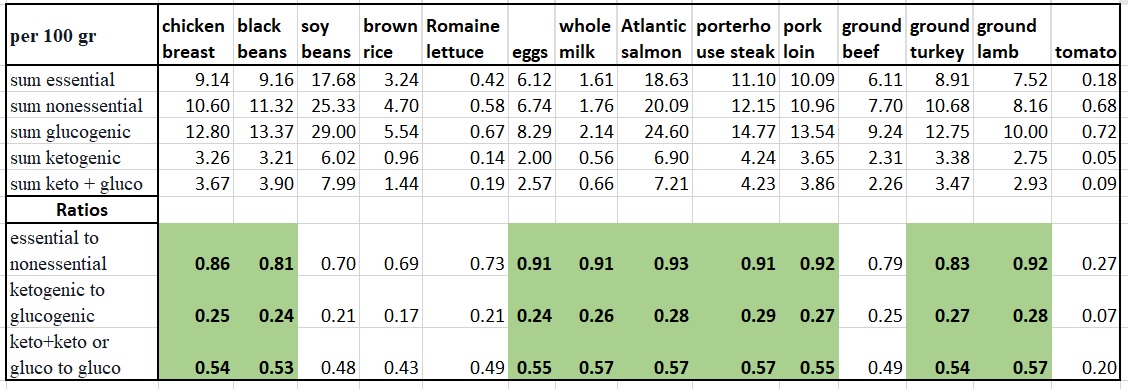
Table 2. Amino acid content in food comparison
As can be seen by the green highlighted columns in table 2, the foods highest in essential amino acids are the same that are also highest in those amino acids that convert to ketones only or either ketones or glucose, and these are: chicken breast, black beans, eggs, whole milk, Atlantic salmon, porterhouse steak, ground turkey, and ground lamb. Notice how soy, a particularly favorite substitution for animal proteins for vegan and vegetarian diets, has nearly equivalently low-quality amino acid profile to brown rice and worse than romaine lettuce. Note also that ground beef has a pretty poor profile, similarly to brown rice and soy beans, and that tomato is negligible in amino acids.
*These foods were chosen by me. Not all foods contain full amino acid profile in the USDA database, but these do.
Proteins in Physiology and in Biology
Physiology deals with how our body works rather than what it is made from. Here protein is looked at for its special shape, the folds, and how it functions. It is looked in a more general term than we are familiar with in common use. Protein is a specially folded complex, large molecular structure made up of amino acids, from which most everything is made in the human body (see here).
Biology deals with the functions and the elements of each cell. In biology, proteins are fundamental components of all living cells and include enzymes, hormones, and antibodies, that are necessary for the proper functioning of an organism.
The physiology and biology of proteins is fascinating and extremely complex. Unlike my initial college class, I think I can do a better job at explaining protein folding and its significance. Protein molecules have polar arms. Polarity means that the molecule as well as its atoms can have either a positive or a negative charge. A positive charge repels something that is positively charged but attracts something that is negatively charged. So the protein folds are generated by these polarity attractions and repels between how the atoms of the chemical elements (noted earlier as N, C, H, and O) are lined up within a particular amino acid and how the amino acids are lined up in a protein molecule. Because all amino acids we call Lycine, for example, look and function alike, it follows that all Lycine must be folded identically. If there is damage to a particular amino acid, it may change its shape, thereby lose its function and the protein in which it is found will also lose its ability to function.
A protein damage can be local or systemic. By local, think of having a scalding hot water spray on your arm and damage your skin in one spot. Since your skin is high in protein, the hot water had damaged a few protein cells on your skin. One can also envision a local protein damage by cooking. Heat-damaged protein in foods we intentionally heat (cook) end up with “untangled” (unfolded) proteins. This makes the food easier the chew.
What can cause such damage to proteins in our body in general? Proteins make up a large part of all of our organs, skin, hair, and just about everything we can think of. So anything that can cause damage to our body will damage our proteins. A simple example is a sunburn, where we burn the skin, which contains a lot of protein, we damage the protein structures. More common modern nutritional examples are metabolic diseases, which affect many organs, such as the liver (non-alcoholic fatty liver disease), arteries and heart (atherosclerosis), metabolism (insulin resistance, type 2 diabetes, and obesity), some cancers, various cognitive disorders, such as Alzheimer’s disease, autoimmune diseases like irritable bowel syndrome (IBS), Crohn’s disease, Hashimoto’s disease, Multiple Sclerosis, etc.
Conclusion
The goal of this paper was to help you see the many meanings of the word protein and the importance of understanding the various meanings. Selecting the right food to eat based on its protein quality (amino acid constituents) is a complicated business. Not only it is important to understand based on what we should be selecting our diet (such as carnivore versus vegan, for example) but also the foods within each diet. It is often brought up that some nutritional regimes are less healthy than others. It is easier to determine the facts, if we can look at the nutritional components of the particular regime at the molecular level.
We Need Your Help
More people than ever are reading Hormones Matter, a testament to the need for independent voices in health and medicine. We are not funded and accept limited advertising. Unlike many health sites, we don’t force you to purchase a subscription. We believe health information should be open to all. If you read Hormones Matter, like it, please help support it. Contribute now.
Yes, I would like to support Hormones Matter.
Image credit: Angela Stanton.
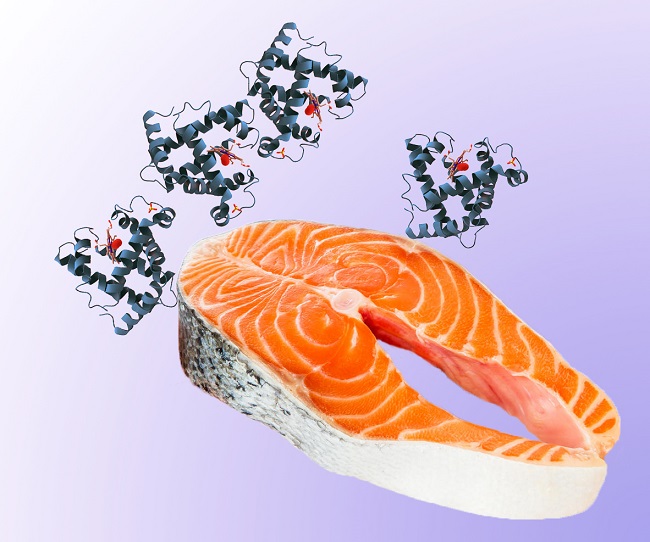






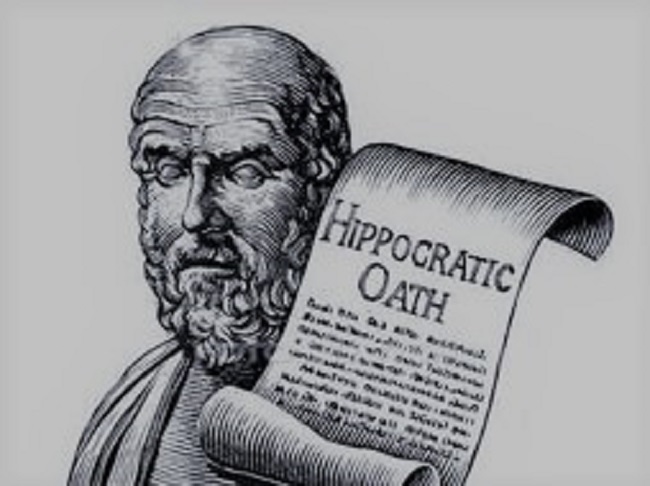






I’ve read many diabetics say that steak causes a higher insulin spike than ground beef. This seems to contradict the amino to glucose figures in your article. Any ideas why the difference? Thx
Dear Bonni,
There is no contradiction at all. Within beef types, there are huge differences in how much leucine they contain. Leucine is the rate-limiting factor of what will become glucose versus being synthesized into muscles. Approximately 60% of animal protein–plant proteins even larger percent–are glucogenic, meaning they convert to glucose. Of the 20 amino acids, 11 amino acids are nonessential and 9 essential. Of the nonessential, 10 mandatiorily convert only to glucose, an 1 either glucose or ketones, depending on the “environment”. Of the 9 essential amino acids, 3 are glucogenic, 2 are ketogenic, and 4 either glucogenic or ketogenic. There is great importance to glucose and insulin spike of those amino acids can be either glucose or ketone metabolic amino acids.
If the leucine threshold of the person eating protein is not met, protein synthesis will not commence. In this case amino acids that can be used either as glucose or ketones will be used as glucose, as well as since protein synthesis didn’t start, the glucogenic amino acids are used as glucose instead of energy to help protein synthesis. So it matters how much protein one eats with how much leucine in it, and not so much whether it is ground beef versus a steak.
The difference that people describe probably comes from the fact that one can eat more of a burger meat (ground steak) than a steak itself. This is well understood, by the way, and most people having trouble with meat digestion are recommended to eat meat ground for easier digestions. So likely those diabetics who get a higher spike from steak are not eating enough of the steak to meet their leucine threshold, at which point the protein converts to glucose and spikes both bg and insulin.
The leucine threshold is age and activity dependent. A person of age 30 will have a much lower leucine threshold than the same person at age 50 and the same person at age 60. That same person will also have leucine threshold variations based on physical activity. Physical activity increases the body’s ability to process protein; the leucine threshold drops. So before exercise, a 50-year old person may need 3.5 gr leucine to start synthesis, but after an hour of weight lifting, that same person may only need 2.8 gr leucine to start protein synthesis.
With these great number of variables already, we have to add one more: maximum protein synthesis ability. This refers to the speed with which the body is capable to synthesize within a certain amount of time. This maximum decreases with age. So a person at age 30 can synthesize much more protein than the same person at age 50 and more than at age 60. Exercise also affects this maximum; a person’s maximum is increased by exercise.
So, to sum up, an inactive middle-aged person with T2D will have trouble synthesizing a 10-oz steak and will turn ~60% to glucose but a 30-year old person with T2D after gym may not get spiked from that because protein synthesis is possible. But the same inactive person with T2D may be able to metabolize 10 oz burger because it is ground and hence the metabolic process may speed up digestion, meeting the leucine threshold. Which, by the way, needs to be a bolus amount, meaning in one meal. Eating a hamburger in 10 minutes will lead to a better outcome, in terms of this bolus amount of leucine, than eating the same in 1 hour.
I hope this makes sense.
Angela
Thank you! This is a great explanation. From you recent podcast, it is my understanding that in order to fine your personal leucine reqt, blood glucose should basically be a flat line throughout the day (on a very low carb diet) – correct?
That’s correct Bonni. The variability should be minimal. Some variability is expected but minimal. I see the variability within 15 mg/dL points, like 80-95 mg/dL or 85-99 mg/dL usually.
Angela
What about the number of protein meals a day? How does the body handle multiple protein feedings, all meeting your personal leucine threshold?
Bonni,
It depends on what “multiple feedings” means and what you are eating the protein with. There is a large difference between eating 3 servings of meat a day, each meeting the leucine threshold of the individual–say 3 gr leucine, which is about 30 gr meat protein, about 5-6 oz steak (depends on cut)–versus eating 3 meals of beans, soy, and ice cream for protein. See what I mean? Even if I am assuming that those reading the article on protein understand the differences between protein sources and eat animal products for their protein, eating a 6 oz steak for it’s protein with a couple of corn tortillas may just block protein absorption significantly enough such that synthesis will not start.
Taking only animal protein–say 6 oz steak 3 times a day–with no side dishes will provide you with ongoing protein synthesis as much as your body’s upper protein synthesis maximum will allow. The rest will be utilized elsewhere, including some converted to glucose. I see nothing wrong with this.
Best,
Angela
Sometimes (who am I kidding, it’s most times!) I’m left reeling and stumbling with awe at your brilliant ability to take the dullest and most complex of subjects and make them simple and accessible. Without a doubt you’ve now excelled even your high standards with this article. I can now toss out all the others I’ve been keeping and use this as my go-to henceforth. Thank you!
Thanks Lucrecia! I am so glad that you find this article interesting and helpful. Those were my goals in writing it. <3
Angela
Agreed! – especially the table of amino-acids which I haven’t seen presented like that before.
A problem I have (diabetic) is that animal proteins come with fat, some of which is saturated. Vegetable proteins always come with carbs which I obviously have difficulty metabolising. Without the carbs I can metabolise those fats just fine. Since most of the population is now diabetic or prediabetic this makes the push towards veganism quite dangerous.
Very true Chris. All vegans I work with have T2D at some level that can only be detected with a Kraft in-situ-like blood glucose test that is 5 hours long. I call chronic insulin resistance type 2 diabetes… they are the same disease in different stages.
Great info, Angela. Now I know more.
Thanks Roald! 🙂 I hope people find this useful.
Angela